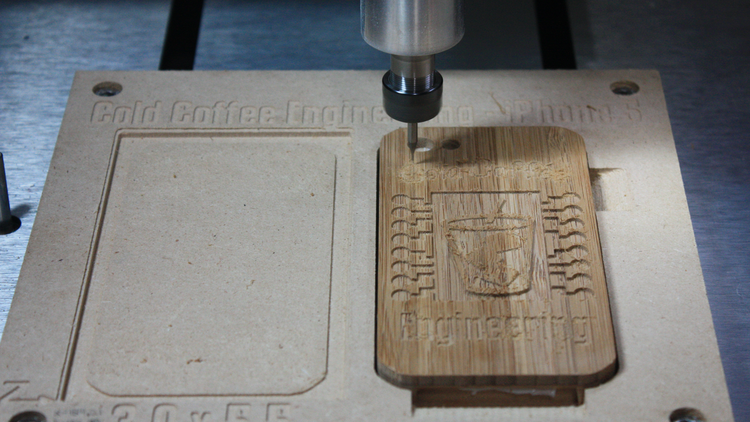First a disclaimer: I have no CNC or CAD experience, my kid is taking Engineering classes in high school and does have some basic CAD training, but for the most part we are flying blind. These posts are probably meaningless to those that have experience. However for those that are new to this maybe these posts will help you.
Now for our 4th project, so much to cover as we have learned a lot. If you have teenage kids you know their mobile phone is VERY important to them, Dallas decided the 4th project is to make an iPhone case from wood. Dallas has been working on this project for a couple weeks. So far 7 different iPhone cases have been made and we’ve learned something new with each case.
Prototypes #1 and #2 turned out ok, but they had an odd problem in that they were not flat/level.

This turned into another discussion that suggested our waste board was not level. Using Carbide Motion we measured the Z axis at 16 different places on our waste board and found that there was a 1.88mm difference between the lowest point and the highest point. This was almost the exact variance we measured in the thickness of the top of the iPhone case vs the thickness of the bottom of the iPhone case.
What Dallas did to fix this was to mill off 2mm from the top of the surface. To do this the Carbide Motion was zeroed to the lower left X and Y axis (as per usual), but the Z axis was set to the highest measured value. The Nomad then milled down 2mm, which left us with a flat surface.
So for those new to CNC, CAD or Nomad. I would suggest that THIS be the first project, delay making the wrench for your second project because that project will work better if you start with a level surface. And you will want to go through this same process every time to change the waste board.
Prototype #3 turned out really well, but not perfect. The back-plate was level due to the level surface. The problem we were running into next was the tape, towards the end of the CNC process the tape would start to let go which was causing problems.
We had been using the carpet tape that came with Nomad, which works well but it has a weakness. If the bit ever touches the tape (so at the end of the project), it doesn’t cut the tape but rather it pulls and tears the tape which causes the tape to let go. So if you are going to use this tape you need to know where the bit could mill all the way through your material and AVOID having tape in that area.
I had been applying the tape to the edges along the back side of our 3.5” by 5.5” blocks of wood. But this was where the bit was actually milling all the way through (to effectively cut out the iPhone case). When I applied tape to the center (avoiding the camera cutout) the tape held through the entire project.

We tried Scotch/3M Two-Sided Outdoor Mounting tape . This tape held VERY well but it had a problem as it was just too strong. We broke Prototype #4 trying to get it unstuck from the waste board. Be aware that there are three kinds of this tape. The link above is to the 20lbs version, which is amazingly strong and would be good if you were working with thick wood or metal. This tape is also thicker, so there is more of a gap between your material and the waste board. I liked the bigger gap as we could cut all the way through our material without cutting into the waste board.
There is also a 10lbs version which worked better for us, but still a little too strong. There is also a 5lbs version which we have not tried, not sure if this has any advantages over the carpet tape. So we now have a Goldilocs and the Three Bears solution, and use different tape depending on what we are doing.
This project isn’t over, Dallas is going to try different kinds of wood. The (cheaper) pine we have been using is pretty light. After four days of use a corner broke. There was also one day that the wood appeared to contract a little and the phone would slide out of the case, but the next day it was fine again. Friends (and the Engineering teacher) have asked Dallas to make them iPhone cases, but it needs to get a little better first. So there could be updates to this story in the future.
